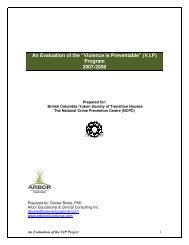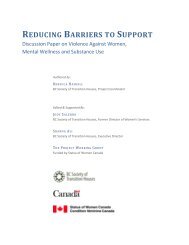An Evaluation of the Violence is Preventable (VIP) Program
An Evaluation of the Violence is Preventable (VIP) Program
An Evaluation of the Violence is Preventable (VIP) Program
Create successful ePaper yourself
Turn your PDF publications into a flip-book with our unique Google optimized e-Paper software.
affected in many ways, including <strong>the</strong>ir ability to learn, social relationships, mental health and<br />
behavior. Ultimately, we all have investment in helping children and youth who have been<br />
impacted by domestic violence so that <strong>the</strong>y can grow up into healthy, caring citizens. At <strong>the</strong><br />
same time, it <strong>is</strong> important to focus on prevention. Through <strong>VIP</strong> presentations given in <strong>the</strong><br />
classrooms, students learn what healthy relationships look like, and where <strong>the</strong>y can go now or<br />
in <strong>the</strong> future for support should <strong>the</strong>y find <strong>the</strong>mselves in a violent relationship. Working to break<br />
<strong>the</strong> cycle <strong>of</strong> intergenerational violence <strong>is</strong> critical to <strong>the</strong> health <strong>of</strong> our society.<br />
Educator Awareness<br />
It <strong>is</strong> clear from educators’ feedback <strong>is</strong> <strong>the</strong> level <strong>of</strong> need in relation to education around <strong>is</strong>sues <strong>of</strong><br />
domestic violence. Teachers reported a great deal <strong>of</strong> learning in regards to <strong>the</strong> impact <strong>of</strong><br />
domestic violence, signs that impacted students may exhibit, basic strategies to use in <strong>the</strong><br />
classroom to ass<strong>is</strong>t <strong>the</strong>se students and where to get more help in <strong>the</strong> community. Educators do<br />
not receive th<strong>is</strong> training during teacher education and very rarely are <strong>the</strong>re pr<strong>of</strong>essional<br />
development opportunities in th<strong>is</strong> area. At <strong>the</strong> same time, stat<strong>is</strong>tics have shown that 3 to 5<br />
children in a classroom are impacted by domestic violence. Teachers struggle with <strong>the</strong> ability to<br />
identify <strong>the</strong>se students and to understand <strong>the</strong> underlying <strong>is</strong>sues that have led to challenges in<br />
<strong>the</strong>ir day-to-day lives. Teachers are uncertain how to support <strong>the</strong>se students in overcoming <strong>the</strong><br />
impact <strong>of</strong> domestic violence. Teachers included in th<strong>is</strong> evaluation were clear that <strong>the</strong>y would like<br />
more pr<strong>of</strong>essional development opportunities to learn specific ways <strong>of</strong> working with <strong>the</strong>se<br />
students so that in turn students can experience success.<br />
Overall, educators were surpr<strong>is</strong>ed at <strong>the</strong> prevalence <strong>of</strong> domestic violence in Canadian society.<br />
One third <strong>of</strong> educators noted <strong>the</strong> high rates <strong>of</strong> domestic violence as shocking. Th<strong>is</strong> speaks to<br />
<strong>the</strong> need for greater public education around th<strong>is</strong> social problem that occurs in all <strong>of</strong> our<br />
neighborhoods. Without proper training and education, teachers will continue to feel helpless in<br />
working with students who are impacted by domestic violence and in turn, those students will<br />
lose out on learning and support opportunities.<br />
Teachers also noted <strong>the</strong> importance <strong>of</strong> school-community partnerships in addressing <strong>is</strong>sues <strong>of</strong><br />
domestic violence. Almost all (92%) teachers indicated that a partnership between schools and<br />
<strong>VIP</strong> <strong>is</strong> beneficial for schools. There <strong>is</strong> a recognition that teachers are increasingly asked to<br />
address <strong>is</strong>sues in <strong>the</strong> school setting for which <strong>the</strong>y feel ill-equipped. By removing <strong>the</strong> burden<br />
from teachers by providing <strong>the</strong>m with training and education so <strong>the</strong>y can both ass<strong>is</strong>t in <strong>the</strong><br />
classroom and provide children and youth with community agency services, we capitalize on <strong>the</strong><br />
strengths <strong>of</strong> both partners. Through th<strong>is</strong> network <strong>of</strong> support, children and youth can thrive in all<br />
areas <strong>of</strong> development.<br />
Services for Students<br />
Students who participated in <strong>the</strong> evaluation <strong>of</strong> groups and classroom presentations indicated<br />
great benefit from <strong>the</strong>se activities. For students who participated in <strong>the</strong> groups, growth was<br />
observed from <strong>the</strong> beginning to <strong>the</strong> end in all areas examined through <strong>the</strong> student self-report.<br />
These include social skills (getting along with o<strong>the</strong>rs), l<strong>is</strong>tening skills, solving problems without<br />
<strong>the</strong> use <strong>of</strong> physical aggression and feelings <strong>of</strong> adult support. Fur<strong>the</strong>r to th<strong>is</strong>, all students across<br />
37 | F a l l 2 0 0 8 V I P E v a l u a t i o n






